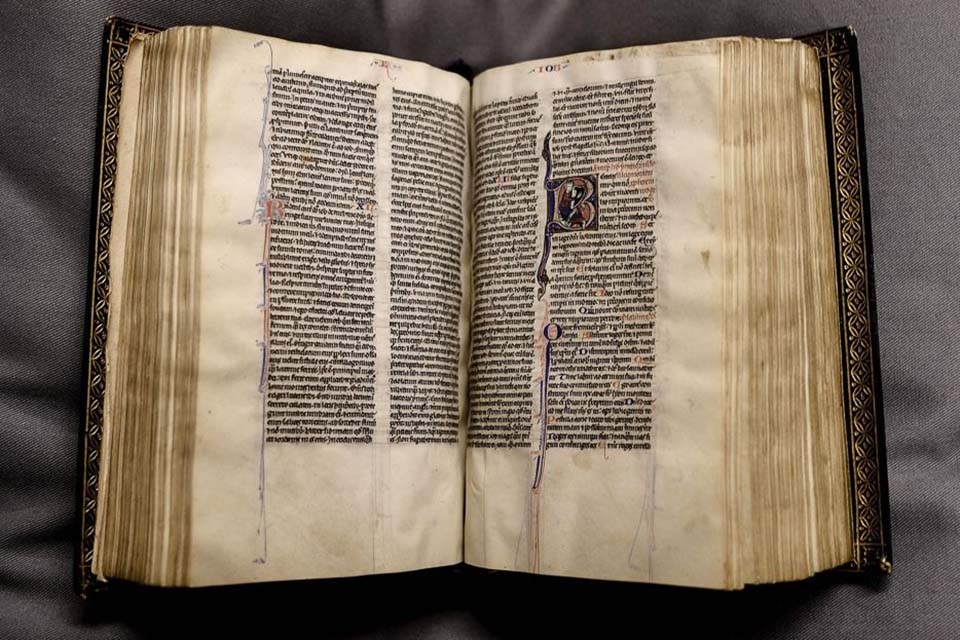A major new exhibition in Canterbury Cathedral’s Crypt allows visitors to explore up close, for the first time, a unique collection of artefacts – including the battle shield, gauntlets and jupon of The Black Prince (1330-1376)
The new exhibition in Canterbury Cathedral focuses on the complex relationship between Church and State and the struggles between archbishops and kings. With a particular focus on Canterbury Cathedral’s important role within this relationship, the Cathedral’s buildings, collections, and stories shed light on the manifold ways, in which the medieval church and state interacted.
The national and international dimensions of Church-State relations will also be explored, including how they have changed and developed over the centuries – from the Cathedral’s 6th-century origins, through the upheaval of the later Anglo-Saxon period, to the remodelling of both buildings and religious practice forced by the Norman Conquest, and beyond.
Exciting objects that visitors will be able to see in the exhibition include:
Grant from William de Tracy
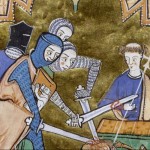 William de Tracy is one of the four knights who murdered Thomas Becket in Canterbury Cathedral in 1170. In 1173-4, de Tracy made a grant of 100 shillings (equivalent of approx. £10,000 today) as a penitential gesture for his role in the killing very soon after Becket was made a saint. The grant consisted of “Doccombe with its appurtenances & with the adjacent lands”. The said manor is one of the best documented manorial properties with an archive reaching back to the period of the murder and up to the dissolution.
William de Tracy is one of the four knights who murdered Thomas Becket in Canterbury Cathedral in 1170. In 1173-4, de Tracy made a grant of 100 shillings (equivalent of approx. £10,000 today) as a penitential gesture for his role in the killing very soon after Becket was made a saint. The grant consisted of “Doccombe with its appurtenances & with the adjacent lands”. The said manor is one of the best documented manorial properties with an archive reaching back to the period of the murder and up to the dissolution.
William de Tracy was not just one of the four knights, who attacked the Archbishop and Canterbury. He was also was the one, who sliced off the crown of the saintly head. Afterwards, William de Tracey sought absolution, which he and the other three culprits gained from the Pope by going on a pilgrimage to Jerusalem and join the Templars. Apparently, he either died with the other murderers while doing penance in Jerusalem; or – as recounted by Herbert of Bosham – he died a gruesome death in Cosenza in Southern Italy. The grant is witnessed by the Abbot at St. Eufemia’s Abbey in Aspromonte, which does lend some confirmation to the account of Herbert of Bosham.
The Accord of Winchester
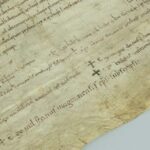 This 11th-century document, witnessed by William the Conqueror, his queen, Matilda, and Lanfranc, the Archbishop of Canterbury, amongst others, records the settlement establishing the supremacy of the Archbishop of Canterbury over the Archbishop of York. Each witness subscribed to the agreement by marking crosses, presumably in their own hand. The Accord was signed in 1072 AD. The accord likely reflected the continued hostilities, which Wlliam encountered in the north.
This 11th-century document, witnessed by William the Conqueror, his queen, Matilda, and Lanfranc, the Archbishop of Canterbury, amongst others, records the settlement establishing the supremacy of the Archbishop of Canterbury over the Archbishop of York. Each witness subscribed to the agreement by marking crosses, presumably in their own hand. The Accord was signed in 1072 AD. The accord likely reflected the continued hostilities, which Wlliam encountered in the north.
The Lyghfield Bible
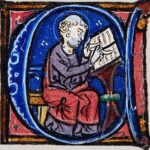 Lost during the 16th century, the Lyghfield Bible was recently returned to Canterbury Cathedral. The Manuscript was acquired by the Cathedral for the sum of £100.000. This is a rare example of a completely illuminated book from the collection now held at the Cathedral. The Lyghfield Bible is a late 13th-century, 690-leaf, pocket Bible, measuring 17,3 cm x 11,2 cm. The bible, although smaller than an Ipad, is carefully written on high quality and very thin parchment or vellum with “Pearl Script”. Likely, the manuscript was made in Paris
Lost during the 16th century, the Lyghfield Bible was recently returned to Canterbury Cathedral. The Manuscript was acquired by the Cathedral for the sum of £100.000. This is a rare example of a completely illuminated book from the collection now held at the Cathedral. The Lyghfield Bible is a late 13th-century, 690-leaf, pocket Bible, measuring 17,3 cm x 11,2 cm. The bible, although smaller than an Ipad, is carefully written on high quality and very thin parchment or vellum with “Pearl Script”. Likely, the manuscript was made in Paris
The Liudhard Medalet
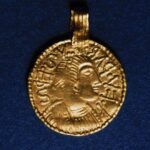 The first known piece of Christian art made in England after the arrival of the Anglo-Saxons, this 6th century gold medalet shows Bishop Liudhard, whose arrival in Kent from the Frankish court started the conversion of the Anglo-Saxons to Christianity. Liudhard accompanied the Frankish princess Bertha, who married the pagan King Æthelberht of Kent. Likely, the medalet was part of a necklace featuring eight other coins or medallions, among those one of the earliest presentations of St. Martin. The medalet itself is a gold coin. On the obverse side is a bust of a man wearing a diadem and a robe encircled with the legend “LEV·DΛR·~VS·EPS”. On the reverse side of the coin appears a patriarchal cross set on a base with two pendants descending from the upper arm of the cross. Discovered in a grave in 1844 in the graveyard in St. Martin’s at Canterbury, the medalet is on loan from National Museums Liverpool.
The first known piece of Christian art made in England after the arrival of the Anglo-Saxons, this 6th century gold medalet shows Bishop Liudhard, whose arrival in Kent from the Frankish court started the conversion of the Anglo-Saxons to Christianity. Liudhard accompanied the Frankish princess Bertha, who married the pagan King Æthelberht of Kent. Likely, the medalet was part of a necklace featuring eight other coins or medallions, among those one of the earliest presentations of St. Martin. The medalet itself is a gold coin. On the obverse side is a bust of a man wearing a diadem and a robe encircled with the legend “LEV·DΛR·~VS·EPS”. On the reverse side of the coin appears a patriarchal cross set on a base with two pendants descending from the upper arm of the cross. Discovered in a grave in 1844 in the graveyard in St. Martin’s at Canterbury, the medalet is on loan from National Museums Liverpool.
The Canterbury Cross from c. 850
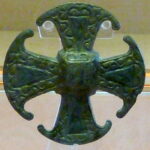 The brooch is a significant example of Anglo-Saxon Christian art with deep connections to the religious and cultural heritage of the city of Canterbury and the wider Anglican Communion. The original cross is a bronze cruciform brooch, with triangular panels of silver, incised with a triquetra and inlaid with niello. This cross features a small square in the centre, from which extend four arms, wider on the outside, so that the arms look like triangles, symbolising the Trinity. The tips of the arms are arcs of a single circle, giving the overall effect of a round wheel. The four arms come together at the centre in a raised square, and are wider and curved at their outer points, giving the impression of a circle. On loan from Canterbury Museums and Galleries.
The brooch is a significant example of Anglo-Saxon Christian art with deep connections to the religious and cultural heritage of the city of Canterbury and the wider Anglican Communion. The original cross is a bronze cruciform brooch, with triangular panels of silver, incised with a triquetra and inlaid with niello. This cross features a small square in the centre, from which extend four arms, wider on the outside, so that the arms look like triangles, symbolising the Trinity. The tips of the arms are arcs of a single circle, giving the overall effect of a round wheel. The four arms come together at the centre in a raised square, and are wider and curved at their outer points, giving the impression of a circle. On loan from Canterbury Museums and Galleries.
The Black Prince’s Cap of Maintenance
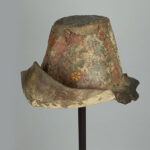 The Cathedral is home a unique “Cap of Maintenance”, which was part of the burial accoutrements of the Black Prince. Laid to rest next to Thomas Becket’s tomb, the cap was part of a uniqe outfit reqested by the Black prince to be hung above his tomb for eternity. Today, the different parts are so fragile that they have been replaced by copies. However, at the new exhibition visitors have a unique possibility to see the originals.
The Cathedral is home a unique “Cap of Maintenance”, which was part of the burial accoutrements of the Black Prince. Laid to rest next to Thomas Becket’s tomb, the cap was part of a uniqe outfit reqested by the Black prince to be hung above his tomb for eternity. Today, the different parts are so fragile that they have been replaced by copies. However, at the new exhibition visitors have a unique possibility to see the originals.
SOURCE:
PRESS RELEASE. Canterbury Cathedral
READ MORE:
A number of the exhibited treasures are presented and discussed in a small booklet:
